Beyond Conflict-Free: The Truth About Diamond Ethics & Why Lab-Grown Diamonds Are the Truly Ethical Choice

While the term "conflict-free" diamonds suggests ethical sourcing, the reality reveals significant gaps in this certification. This article investigates how the Kimberley Process fails to address human rights abuses, environmental damage, and poor working conditions in diamond mining. Lab-grown diamonds offer a genuinely ethical alternative by eliminating mining entirely, providing complete supply chain transparency, and reducing environmental impact—all while delivering identical quality at better value.
When shopping for diamond jewellery, particularly engagement rings, many consumers seek assurance that their purchase doesn't fund violence or exploitation. The term "conflict-free" has become a common certification in the diamond industry, ostensibly guaranteeing ethical sourcing. But what if this reassurance is built on shaky foundations?
At Lark & Berry, we believe consumers deserve transparency about what truly makes a diamond ethical. This investigative piece cuts through marketing language to reveal uncomfortable truths about diamond sourcing and why lab-grown diamonds represent the only genuinely ethical choice for conscientious consumers.
The Origins of "Conflict-Free": Understanding the Kimberley Process
The concept of "conflict-free" diamonds emerged in response to horrific human rights abuses funded by diamond sales in the 1990s, particularly in Sierra Leone, Angola, and the Democratic Republic of Congo. These "blood diamonds" financed brutal civil wars, resulting in the deaths of millions.
In 2003, the Kimberley Process Certification Scheme (KPCS) was established to prevent diamond sales from funding conflicts. While this represented progress, nearly two decades later, significant ethical gaps remain unaddressed.
Myth vs. Reality: What "Conflict-Free" Actually Means
Myth: "Conflict-free" diamonds are ethically sourced and free from human rights concerns.
Reality: The Kimberley Process narrowly defines "conflict diamonds" as rough diamonds used by rebel movements to finance wars against legitimate governments. This definition ignores human rights abuses by governments themselves, child labour, environmental devastation, and worker exploitation.
According to Global Witness, one of the organisations that helped establish the Kimberley Process, the certification "has refused to evolve and address the clear links between diamonds, violence and tyranny." In fact, Global Witness withdrew its support for the Kimberley Process in 2011, citing its failure to address human rights concerns in Zimbabwe's diamond fields.
The Ethical Blind Spots of "Conflict-Free" Mined Diamonds
The "conflict-free" label creates a false sense of ethical assurance while leaving critical issues unaddressed:
1. Human Rights Abuses Continue
Even certified "conflict-free" diamonds may come from regions where serious human rights violations occur. The narrow definition of "conflict diamonds" means that diamonds from areas with documented government-sanctioned violence can still receive certification.
A 2018 report by Human Rights Watch found that major jewellery brands couldn't assure consumers that their diamonds were free from human rights abuses, despite selling "conflict-free" diamonds.
2. Environmental Devastation
Diamond mining causes severe environmental damage regardless of conflict status:
- A single one-carat diamond requires the removal of approximately 250 tonnes of earth
- Diamond mining contributes to deforestation, soil erosion, and ecosystem destruction
- Mining operations contaminate water sources with chemicals and sediment
- The carbon footprint of mined diamonds is significantly higher than lab-grown alternatives
The Kimberley Process entirely ignores environmental impacts, meaning a diamond can be certified "conflict-free" despite causing ecological devastation.
3. Poor Working Conditions and Exploitation
Many diamond miners work in dangerous conditions for minimal pay. The International Labour Organisation estimates that thousands of children work in diamond mines across Africa, often in hazardous conditions that threaten both their health and education.
These labour issues remain completely unaddressed by the "conflict-free" certification.
Expert Tip: When evaluating diamond ethics, look beyond simplistic "conflict-free" claims. Ask specific questions about human rights standards, environmental impact, and labour practices throughout the entire supply chain. Better yet, consider lab-grown diamonds that eliminate these concerns entirely while offering superior value and identical quality.
Supply Chain Transparency: The Tracking Problem
Perhaps the most fundamental issue with "conflict-free" mined diamonds is the lack of genuine traceability:
The Diamond Pipeline Problem
Once mined, diamonds pass through numerous hands—local buyers, exporters, cutting facilities, wholesalers, and retailers—often crossing multiple international borders. This complex supply chain makes true tracking nearly impossible.
A 2018 investigation by the Financial Times found that certificates of origin could be forged or mixed, allowing diamonds from problematic sources to enter the legitimate supply chain. Despite blockchain initiatives and other tracking technologies, complete transparency remains elusive for mined diamonds.
The reality is that when purchasing a "conflict-free" mined diamond, consumers have very limited visibility into its true origins and the conditions under which it was produced.
Lab-Grown Diamonds: The Truly Ethical Alternative
While the diamond mining industry struggles with ethical challenges, lab-grown diamonds offer a genuinely ethical alternative that eliminates these concerns entirely.
Complete Supply Chain Transparency
Lab-grown diamonds, like those exclusively used by Lark & Berry, provide complete transparency from creation to setting. Created in controlled laboratory environments rather than extracted from the earth, these diamonds have a clear, traceable origin free from ethical ambiguity.
Identical Quality, Superior Ethics
Lab-grown diamonds are chemically, physically, and optically identical to mined diamonds. They're certified by the same gemological institutes (GIA, IGI) using the same 4Cs—Cut, Colour, Clarity, and Carat.
Environmental Benefits
Lab-grown diamonds typically have a carbon footprint that's 85-98% smaller than mined diamonds. They require no land disruption, use significantly less water, and avoid the ecosystem destruction inherent in mining operations.
By choosing lab-grown diamonds, consumers actively reduce environmental harm while enjoying beautiful jewellery.
Transparency in Action: The Lark & Berry Difference
As pioneers in the lab-grown diamond space, Lark & Berry has built a brand based on genuine ethics rather than marketing language:
- Zero-Mining Guarantee: By exclusively using lab-grown diamonds and gemstones since our founding in 2018, we eliminate all mining-related ethical concerns
- Full Traceability: Every diamond we use has a clear origin story that can be traced from creation to setting
- Certified Quality: Our diamonds are certified by the same respected gemological institutes that grade mined diamonds
- Value Advantage: Without the inflated costs of mining operations, our diamonds typically cost 20-40% less than mined equivalents of the same quality
"When we founded Lark & Berry, we made a conscious decision to work exclusively with lab-grown diamonds. This wasn't just about creating beautiful jewellery—it was about pioneering a truly ethical alternative in an industry plagued by questionable practices." - Laura Chavez, Founder
Frequently Asked Questions About Diamond Ethics
Are lab-grown diamonds "real" diamonds?
Yes, lab-grown diamonds are chemically, physically, and optically identical to mined diamonds. They are real diamonds in every scientific sense, composed of carbon atoms arranged in the characteristic diamond crystal structure. The only difference is their origin—they're grown in controlled laboratory conditions rather than formed in the earth.
Do lab-grown diamonds look different from mined diamonds?
No, lab-grown diamonds are visually indistinguishable from mined diamonds, even to trained gemologists using standard equipment. Both types of diamonds are graded using the same criteria (the 4Cs: cut, color, clarity, and carat) by the same certification bodies.
Is the Kimberley Process effective at preventing blood diamonds?
While the Kimberley Process has reduced the flow of diamonds from conflict zones, its narrow definition of "conflict diamonds" fails to address many ethical issues. It does not account for human rights abuses by governments, environmental damage, child labour, or poor working conditions—all of which can exist in certified "conflict-free" diamonds.
Why are lab-grown diamonds less expensive than mined diamonds?
Lab-grown diamonds are typically 20-40% less expensive than comparable mined diamonds because they eliminate the extensive costs associated with mining operations, including exploration, extraction, and the complex supply chain of intermediaries. This price advantage comes without compromising on quality or beauty.
Making the Ethical Choice
As consumers become increasingly aware of the ethical limitations of "conflict-free" mined diamonds, more are turning to lab-grown alternatives that offer genuine peace of mind.
By choosing lab-grown diamonds, you're not compromising on quality or beauty—you're making a conscious decision to support transparent, ethical practices while enjoying exceptional value.
The diamond industry is at a crossroads, with innovation offering a path forward that aligns with modern ethical values. By looking beyond marketing terms like "conflict-free" and demanding truly ethical practices, consumers can drive positive change throughout the industry.
At Lark & Berry, we're proud to be at the forefront of this ethical revolution, offering luxurious, sustainable fine jewellery that you can wear with genuine pride and confidence.
Experience Truly Ethical Luxury
Discover our collection of exquisite lab-grown diamond jewellery that combines ethical sourcing with exceptional craftsmanship and design. From stunning engagement rings to everyday luxuries, our pieces offer beauty without compromise.



